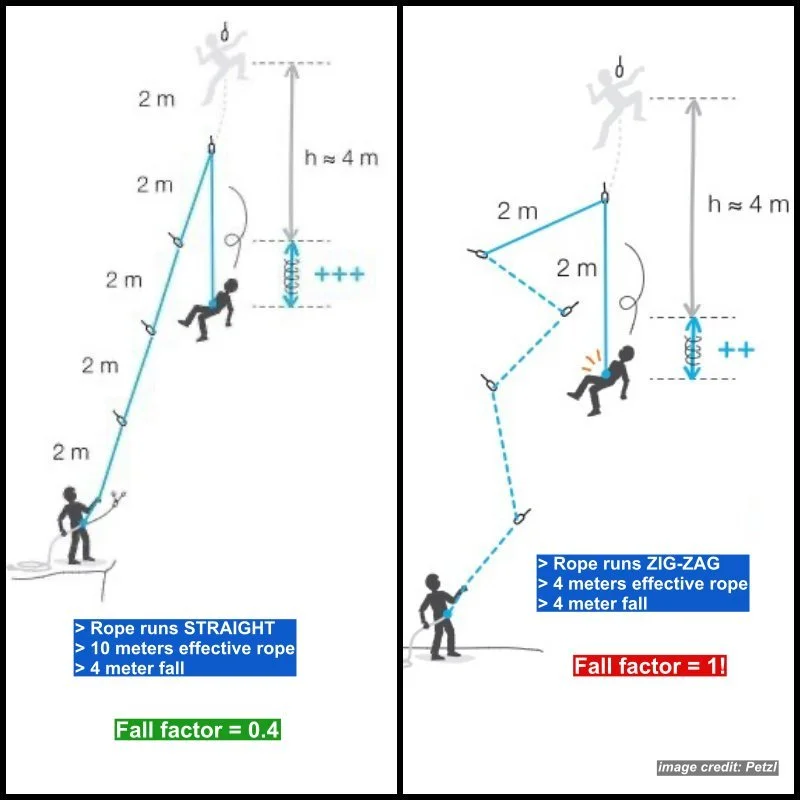How can rope drag increase your fall factor?
The idea of fall factor is a fundamental concept in climbing. It’s mentioned in most all the books, and hopefully you learned it on your first day leading.
Short version:
On a multipitch route, if you take a fall close to the belay without much rope to absorb the force, you can take a high fall factor. Bad!
But as you get higher on the route, there's more rope in the system to absorb the force of a fall, so four factor is not an issue anymore.
However, similar to mechanical advantage, there is a “theoretical” version and an “actual” version, and they can be quite different. Let's take a closer look.
image credit: https://www.petzl.com/US/en/Sport/Fall-factor-and-impact-force---theory?ActivityName=rock-climbing
First, let’s look at the theoretical definition of fall factor.
Fall factor is a way to look at the the relative impact force of a fall. It's a ratio, calculated by dividing the fall distance by the amount of rope between the belayer and the climber.
In normal climbing scenarios, this will always be a number between 0 and 2. (You can’t have a factor 2 fall on a single pitch climb, because you hit the ground, OUCH!)
The higher the fall factor, the greater impact force on the climber and gear.
Takeaway: a lower fall factor is better!
Let's have a look at the diagram above, from the always awesome Petzl website. In both cases, the lead climber falls a distance of 4 meters.
In the left example, the 4 meter fall is divided by 10 meters of rope, which gives a relatively low fall factor of 0.4. That means low forces all the way around: on the belayer, the climber, and the top piece of gear. That's good!
Compare that to the diagram on the right. The climber takes a fall of the same distance, 4 meters, but in this case it's right off of the belay on a multi pitch climb, without clipping any gear, with only 2 meters of rope between him and the belayer. This results in the highest possible fall factor of 2, which puts very large forces on the entire system. That’s bad!
How rope drag affects the “actual” fall factor
If you’re leading with lots of rope out, you might think that fall factor should not be a concern. “Schweeeeeet, I've got 30 meters of rope between me and my belayer. If I fall, all that dynamic rope will give a nice soft catch, so no worries about a big fall factor, right?”
Well, that would be true according to the theoretical model of fall factor. But what about rope drag? How does that affect the theoretical model?
There are two reasons why rope drag is bad.
One of them is pretty obvious: you need to work a lot harder to pull up the rope.
But there’s another, less appreciated and perhaps more important reason: rope drag can increase the actual fall factor.
How does this work? I can't say it better than the Petzl website:
“The theoretical fall factor does not take into account the rope friction against the rock and in quickdraws. This friction prevents the rope from stretching over its entire length. Thus, only a part of the rope (solid line) will absorb the energy of the fall: this is called effective rope length.”
In the diagram below, the lead climber has a lot of rope drag because of the zigzagging route. Even though the leader has 10 meters of rope out and they take a short fall of only 4 meters, that short fall is effectively being absorbed by only 4 meters of dynamic rope (the solid blue line) , which gives a relatively high fall factor 1, ouch!
That could easily be enough force to rip marginal gear out of the rock, injure the climber, and put a big strain on your rope. This can especially be a concern when aid climbing, where you’re often placing small gear that may not hold much more than body weight.
Petzl did some real live-body testing on this; see the article and results here.
image: https://www.petzl.com/US/en/Sport/Fall-factor-and-impact-force---theory?ActivityName=rock-climbing
The “theoretical” fall factor has an equation like this, based on rope length between belayer and climber:
image: https://www.petzl.com/US/en/Sport/Fall-factor-and-impact-force---theory?ActivityName=rock-climbing
The “real” fall factor has an equation like this, using the length of rope that is effectively absorbing the force of a fall.
image: https://www.petzl.com/US/en/Sport/Fall-factor-and-impact-force---theory?ActivityName=rock-climbing
Here's a similar diagram from the excellent book “Higher Education” from Andy Kirkpatrick.
Andy notes that with lots of rope drag on the left, we have a higher peak force over a shorter time (bad). With minimal rope drag on the right, we have a lower peak force absorbed over a longer time (good).
Also note that in the zigzag example on the left, there's basically no force felt by the belayer when the lead climber falls. Typically upward displacement of the belayer can absorb a significant amount of force in the system, but here it's not happening at all.
image: Andy kirkpatrick, “HIGHER Education” used with permission
How can you avoid rope drag?
A properly bolted sport climb should not zigzag too much, so this generally should not be a big issue when clipping bolts.
For traditional climbing, when you're placing gear, bring a good selection of 60 cm and maybe a few 120 cm sewn slings, and extend your gear as needed to keep the rope running as straight as possible. Doing this will minimize rope drag and allow your rope to do its job properly, absorb the falling force along most of its length.
You can use double ropes. With proper clipping technique, even a zigzag route can be adequately protected and rope drag minimized.






